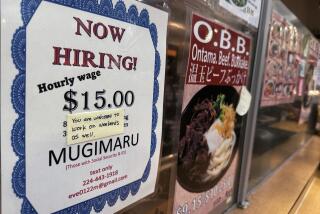Jobless Rate at 6.5%--a 7-Year Low : But Economy Created Few New Positions, Labor Dept. Says
WASHINGTON — The nation’s unemployment rate fell to 6.5% in March, the lowest level in seven years, even though the economy created a disappointingly small number of new jobs, the Labor Department reported Friday.
The good unemployment news was offset by the fact that goods-producing industries lost 68,000 jobs--25,000 of them in the key category of manufacturing.
The decline indicates that the long-awaited turnaround in the trade deficit is still in the future.
Up-Down Pattern
“It suggests that the zigzag pattern of (economic) growth we’ve seen the past two years is still under way: up one month, down another,” said Irwin Kellner, chief economist at Manufacturers Hanover in New York and in recent months an optimist about economic prospects. “It suggests that the trade deficit number we’ll be getting for March in a week or so won’t be as good as we had hoped.”
The Administration, in its assessment, focused on the upbeat side of the report.
The overall payroll employment increase of 766,000 during the first three months of the year is “an impressive gain which indicates that the economy continues to grow and to generate jobs,” said White House spokesman Marlin Fitzwater. “The march of economic progress continues.”
Lowest Since 1980
The March unemployment rate was a tenth of a percentage point below the 6.6% level of the last three months and was the lowest since March, 1980. A separate unemployment measure that excludes members of the armed services in the United States fell the same increment, from 6.7% to 6.6%.
In another report, the Labor Department said civilian unemployment in California was an even 6%, down from 6.2% the previous two months.
The national improvement in unemployment was linked to a slight decline in the size of the work force--those working or looking for work. The jobless total dropped just below 7.9 million, a level unseen since April, 1980, when the work force was much smaller.
Services Dominant
As has been the case in every jobs report in the current expansion, service industries were dominant in the creation of new jobs, adding 232,000 new payroll slots. But with the losses in goods-producing jobs taken into account, the new jobs total was 164,000, an unexpectedly low total after six consecutive months in the 250,000 range.
In another negative note, the Bureau of Labor Statistics, which compiles the monthly employment statistics from Census Bureau surveys of 59,500 households and a separate canvass of about 250,000 businesses, corrected the seasonal adjustment in its report for February and lowered from 350,000 to 250,000 its estimate of new jobs created during that month.
The March report is “another indication that the economy is stuck in another period of weak growth,” said Mark Zande, a labor economist at Chase Econometrics, a Philadelphia economic forecasting firm. “The bright spot was that unemployment edged down,” he said, “but you have to take that with a grain of salt, because it doesn’t mean that more people are working, but that fewer are participating.”
Shorter Work Week
Zande also noted that the length of the work week in manufacturing fell to 40.9 hours from an unusually high 41.2 hours in February--another sign that a hoped-for spurt in goods manufacturing for export may already be slacking off. “There’s not much to be optimistic about,” he said.
Said David Levine of Sanford C. Bernstein & Co., a New York investment banking firm: “For me, the disappointment lies completely in the manufacturing sector. It has been going nowhere; in fact, it’s going backwards.”
One of the few optimistic comments from experts related more to demographics than economics.
Richard W. Rahn, vice president and chief economist of the U.S. Chamber of Commerce, said that with the post-baby-boom generation now beginning to come into the labor force, “we would expect the labor force to begin to grow much slower than in recent years. So the unemployment picture should continue to look good: a steady decline in unemployment--barring a recession. . . . While we didn’t have the job growth we have been getting, it may be the labor force is going to stop growing at a faster rate than the population.”
More to Read
Inside the business of entertainment
The Wide Shot brings you news, analysis and insights on everything from streaming wars to production — and what it all means for the future.
You may occasionally receive promotional content from the Los Angeles Times.









